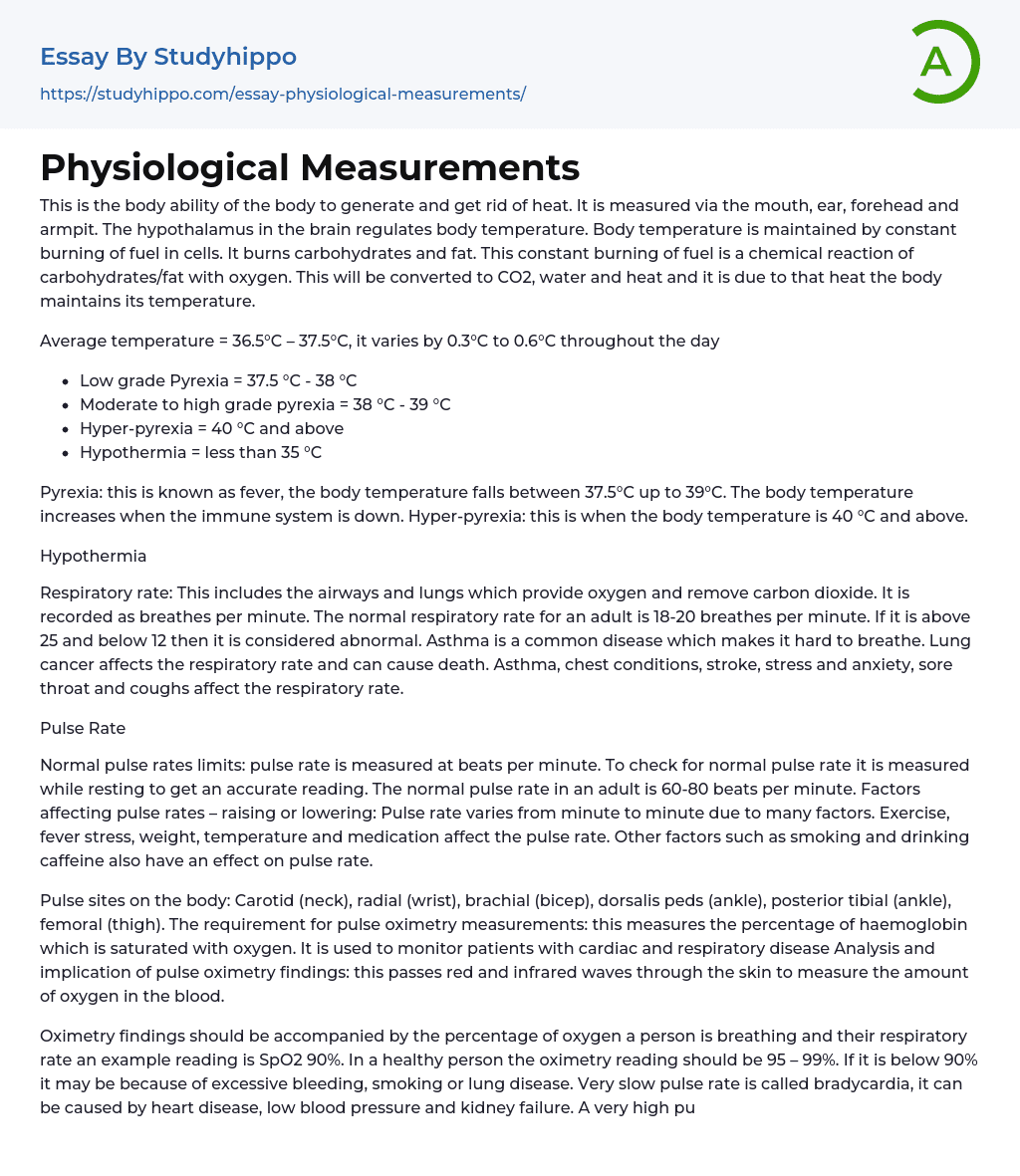This is the body ability of the body to generate and get rid of heat. It is measured via the mouth, ear, forehead and armpit. The hypothalamus in the brain regulates body temperature. Body temperature is maintained by constant burning of fuel in cells. It burns carbohydrates and fat. This constant burning of fuel is a chemical reaction of carbohydrates/fat with oxygen. This will be converted to CO2, water and heat and it is due to that heat the body maintains its temperature.
Average temperature = 36.5°C – 37.5°C, it varies by 0.3°C to 0.6°C throughout the day
- Low grade Pyrexia = 37.5 °C - 38 °C
- Moderate to high grade pyrexia = 38 °C - 39 °C
- Hyper-pyrexia = 40 °C and above
- Hypothermia = less than 35 °C
>
Pyrexia: this is known as fever, the body temperature falls between 37.5°C up to 39°C. The body temperature increases when the immune system is down. Hyper-pyrexia: this is when the body temperature is 40 °C and above.
Hypothermia
Respiratory rate: This includes the airways and lungs which provide oxygen and remove carbon dioxide. It is recorded as breathes per minute. The normal respiratory rate for an adult is 18-20 breathes per minute. If it is above 25 and below 12 then it is considered abnormal. Asthma is a common disease which makes it hard to breathe. Lung cancer affects the respiratory rate and can cause death. Asthma, chest conditions, stroke, stress and anxiety, sore throat and coughs affect the respiratory rate.
Pulse Rate
Normal pulse rates limits: pulse rat
is measured at beats per minute. To check for normal pulse rate it is measured while resting to get an accurate reading. The normal pulse rate in an adult is 60-80 beats per minute. Factors affecting pulse rates – raising or lowering: Pulse rate varies from minute to minute due to many factors. Exercise, fever stress, weight, temperature and medication affect the pulse rate. Other factors such as smoking and drinking caffeine also have an effect on pulse rate.
Pulse sites on the body: Carotid (neck), radial (wrist), brachial (bicep), dorsalis peds (ankle), posterior tibial (ankle), femoral (thigh). The requirement for pulse oximetry measurements: this measures the percentage of haemoglobin which is saturated with oxygen. It is used to monitor patients with cardiac and respiratory disease Analysis and implication of pulse oximetry findings: this passes red and infrared waves through the skin to measure the amount of oxygen in the blood.
Oximetry findings should be accompanied by the percentage of oxygen a person is breathing and their respiratory rate an example reading is SpO2 90%. In a healthy person the oximetry reading should be 95 – 99%. If it is below 90% it may be because of excessive bleeding, smoking or lung disease. Very slow pulse rate is called bradycardia, it can be caused by heart disease, low blood pressure and kidney failure. A very high pulse is called tachycardia this can be due to rigorous exercise, anxiety and excessive bleeding.
- Cloning essays
- Medical Ethics essays
- Patient essays
- Therapy essays
- drugs essays
- Cannabis essays
- Aspirin essays
- Cardiology essays
- Hemoglobin essays
- Pharmacology essays
- Surgery essays
- alternative medicine essays
- Plastic Surgery essays
- Organ Donation essays
- Vaccines essays
- Medical essays
- Dentist essays
- Psychological Trauma essays
- Physical therapy essays
- Cold essays
- Cocaine essays
- Why Marijuana Should Be Legalized essays
- Drug Abuse essays
- Teenage Drug Abuse essays
- Heart Disease essays
- Artery essays
- Algebra essays
- Arithmetic essays
- Correlation essays
- Geometry essays
- Measurement essays
- Price Elasticity Of Demand essays
- Regression Analysis essays
- Statistics essays
- Addiction essays
- Anatomy and Physiology essays
- Biodegradation essays
- Cancer essays
- Dental Care essays
- Disability essays
- Disease essays
- Disorders essays
- Health Care essays
- Infectious Disease essays
- Inquiry essays
- Intelligence Quotient essays
- Lung Cancer essays
- Medicine essays
- Neurology essays
- Nutrition essays




